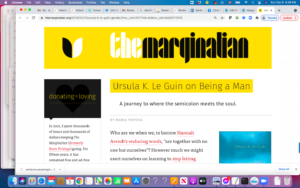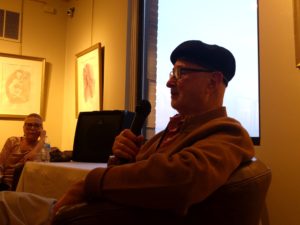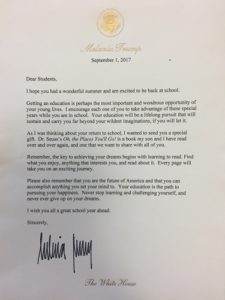Maria Popova Keeps My Heart Open to the World


When gallery owner Richard Michelson asked Jules Feiffer if he wanted a retrospective for his 89th birthday, the brilliant artist replied, “I am doing the best work I’ve ever done and want this exhibit to be new and explosive, with figures sprawling and flying everywhere, and focused on dance…It only took 89 years to figure out how to do this stuff!”

That wonderful and extensive show is now on display at R. Michelson Gallery in Northampton, Massachusetts. We went in to peruse it, and Rich’s wife Jennifer told us that Feiffer was about to do a Q&A. Of course we went upstairs, chatted a bit with Jules and his Phantom Tollbooth collaborator Norton Juster (who lives locally), and settled in to listen.
Jules has a quick and acerbic wit and a strong sense of social justice. Someone asked him what the best response was to the current situation in national politics and he instantly responded with a primal scream. I asked him how he was able to capture the 3-dimensional, flowing art of dance so well in static two-dimensional pictures and he talked about capturing the illusion, that everything was an illusion.
His new work is indeed brilliant. While it descends directly from his famous Village Voice cartoons of he 1960s and 70s, it really is what he told Rich. It has so much vibrancy, often very sophisticated and detailed captioning, and the figures really come alive—especially those using colored inks, which he’s begun to use here and there (though most of the show was black-and-white).
Jules is the latest in a long line of inspirational role models for growing older. I’ve profiled some of them here: Arky Markham, centenarian and activist; Bob Luitweiler, founder of the international homestay organization Servas, for instance I’ve been fortunate to know many others, including Pete Seeger and Chicago Seven/Eight defendant Dave Dellinger—with whom I became friends as a teenaged college student when he was 60, and whom I consider one of my personal mentors—as well as Gray Panther founder Maggie Kuhn; I met her when I was working for the Gray Panthers as a VISTA Volunteer, at the group’s national conference.
These are the kinds of people I want to emulate as I (hopefully) reach well past my current age of 61. When I was a teen activist, I often heard that I was too young to change the world. Now, I’m beginning to hear people tell me I’m too old to do the work I do. But I remind them that Grandma Moses started painting in her 70s and enjoyed a 20-plus-year run as a painter. Today, for example, I’m going networking at a sustainability fair, then attending a peace and tax fairness rally, then hiking a mountain, and probably going out to hear some live music or theater in the evening. You’re only as old as you feel.
“The Post” lives up to the hype. It takes a very cerebral story and builds it into high drama, spurred by strong performances from Meryl Streep as publisher Katharine Graham) and Tom Hanks (editor Ben Bradlee).
The overall message, about the power of the free press, and the need for the press to defend its Fist Amendment freedom, despite the whims of a paranoid and dictatorial president (Nixon, in this case—a different example today).
It tracks Daniel Ellsberg’s smuggling out massive quantities of classified documents from the Rand Corporation, where he worked, and releasing them first to the New York Times, and then to the Washington Post. The movie also dramatizes the frenetic effort throughout the newsroom to absorb the information and turn it into stories on very tight deadlines, not even knowing if the presses would run, while the Times suffered under the first pre-publication censorship of journalism in the history of the United States. Known as “The Pentagon Papers,” these documents proved that US high officials knew by the early 1960s that the war was unwinnable, and that presidents Eisenhower, Kennedy, Johnson, and Nixon all lied to the American people about it.
And it covers the legal battle: the government’s attempt to shut them down and the papers going all the way to the Supreme Court to secure their rights. The timing of these events happened to threaten The Post’s long-awaited IPO, which adds to the drama and the sense of what’s at stake for Graham, Bradlee, and their journalists.
BTW, just as the movie gives lessons on how to survive a paranoid, media-hating president facing serious doubts about his honesty, the Nixon link above focuses on some very interesting parallels between his presidency and that of the current occupant of 1600 Pennsylvania Avenue, Washington, DC. However, let’s remember the differences. Nixon had a very impressive record on the environment—I describe him as the president with America’s second-most environmentalist track record (behind Obama but ahead of both Jimmy Carter and Teddy Roosevelt) also, despite the Vietnam war, did much to break down the barriers between the US and both the Soviet Union and China.
This post was going to be about political correctness overreach and a children’s librarian calling Dr. Seuss racist. That’s the story as a lot of right-wing bloggers and media outlets tell it.
But the real story is about something even bigger: the need to discover the truth. And sometimes that means we have to go to primary sources. Several pieces are in play here, and most of the news coverage is focusing on only one (different sources, different pieces). I thank my journalism training for preventing me from embarrassing myself
Melania (the current US First Lady) donated books to one school in every state.

Most of us will agree that’s a good thing. But as Newsweek reports,
Liz Phipps Soeiro, the school librarian for Cambridgeport [Massachusetts] Elementary School, announced in an open letter to [Melania] that she would not be accepting the gift because her school was not in need of the additional books, also telling the first lady that “Dr. Seuss is a bit of a cliché.” Dr. Seuss!
But here’s the part where I agree with Soeiro, and I had to go to the original Horn Book post to find it: Melania selected only one school in each state. Soeiro found the criteria on the White House website:
“working with the Department of Education to identify schools with programs that have achieved high standards of excellence, recognized by State and National awards and Blue Ribbon Awards…”
Soeiro quite appropriately criticized this process, noting that it transfers more resources to those who already have the most, while schools that would be desperate for books and thrilled to get this donation—schools that are educating their kids with a fraction of the resources wealthy Cambridge (home of Harvard University and MIT) can deploy—are left out because they don’t win awards for excellence. In my opinion, this is like so much else in the DT family agenda. The rich get richer and the poor have 30 or 40 kids in a class and low-quality instructional materials.
Soeiro says,
Are those kids any less deserving of books simply because of circumstances beyond their control? Why not go out of your way to gift books to underfunded and underprivileged communities that continue to be marginalized and maligned by policies put in place by Secretary of Education Betsy DeVos? Why not reflect on those “high standards of excellence” beyond only what the numbers suggest? Secretary DeVos would do well to scaffold and lift schools instead of punishing them with closures and slashed budgets.
And she mailed back the books to the White House.
But wouldn’t it have been more effective to mail those books to one of those deserving schools that don’t win awards? Soeiro could have mailed them, just as publicly, to one of the districts she cites as suffering—Philadelphia, Chicago, or Detroit—or to an underserved community right in Massachusetts, like Holyoke, Springfield (whose mayor said publicly they’d be glad to have the books), or Lawrence. She could have been just as public and gotten just as much attention. Melania will just give them to the next rich runner-up.
That Newsweek article doesn’t quote another part of Soeiro’s letter, published as a blog on the Horn Book children’s lit site (though this article attributed to Newsweek but published on Yahoo does)—but this is the part that has conservatives in a dither:
Another fact that many people are unaware of is that Dr. Seuss’s illustrations are steeped in racist propaganda, caricatures, and harmful stereotypes. [emphasis mine]
OK, let’s talk about the difference between opinion and fact. A fact is something that can be proven (and there’s no such thing as “alternative facts”). A person may have a viewpoint about that fact, and that’s opinion.
Sometimes people discover that their “facts” aren’t actual facts. When my house was built in 1743, the accepted wisdom among colonists of British ancestry was that tomatoes can be lethal, and nobody can go faster than a horse. Anyone stating otherwise would have been called insane.
Of course, these turned out to be opinions. Wrong ones. We know now that tomatoes are not poisonous—and humans can fly around the earth (in the space station) at more than 17,000 miles per hour.
The fact: Seuss’s post-WWII illustrations demonstrate a wide diversity of races and cultures, including many “races” that he made up entirely. Taking his work as a body, humans are only a modest portion of his characters, even his main characters.
Soeiro says his books are based on stereotyping. That’s her opinion and that of the scholars she cites. My opinion is that his books were promoting cultural diversity, acceptance of differences, and a society based in cooperation. I base this on reading many of his works. I’ve read Dr. Seuss books that ridicule…
I’ve also read a number of Seuss books that defend underdogs and the environment (The Lorax)—to name just four of his many books espousing a progressive agenda.
And just as Soeiro cites sources that bolster her opinion, I can cite sources that bolster mine. For example, this profile of Seuss in Tikkun highlights many of his progressive activities and works (although it acknowledges that during WWII, his drawings for adults had a distinctly racist cast when it came to the Japanese. I’m not excusing that but the evidence is strong that he grew out of this attitude, especially in his horror over the Hiroshima bombing).
One not-so-nice thing about our world is that things get all out of proportion because the Internet amplifies opinions better than it amplifies facts. But one very good thing is how easy it is to go to the primary sources. Even if Newsweek hadn’t included the link, it was easy to find Soeiro’s original piece in Horn Book (it came up in the same search results page as the Newsweek article, in fact). And it was just as easy to find the Tikkun piece that mostly supported my position.
So…in any controversy, before you jump up and down and wave banners, take a couple of minutes to determine the facts. Look for coverage in reputable mainstream media whose trained and experienced reporters are vetting stories. Use a fact-checking site like Snopes. And do your part to keep the society-wide conversation focused on the truth and not on wild accusations. Often, as in this case, things are much more nuanced than they seem.
If you’ve been walking around in shock and depression since the election, and you’re anywhere near Minneapolis, get thee to Brave New Workshop, 824 Hennepin Avenue, and buy tickets to “Guardians of the Fallacy: Executive Disorder.” Bring a bunch of liberal and progressive friends.
You need at least one good laugh per day right now. At this show, you’ll make your quota for many weeks.
Founded in 1958, the US’s oldest live political satire troupe may also be its funniest. This show had all four of us roaring with laughter, even if we missed some of the pop-culture references. Only one skit had me scratching my head and saying “huh?” (But a few of them had me asking “what did she just say?”; the enunciation got muddy at times.) I saw The Capitol Steps during the Clinton administration and this was much funnier. All four of us felt it was actually more consistently funny than Saturday Night Live.
This group of five writer/actors has an uncanny ability to get deep into our angst, to express all the fear and worry we face, and to be side-splittingly funny. It’s not really a musical but it has several hilarious song parodies. Remember these names: Lauren Anderson, Denzel Belin, Ryan Nelson, Tom Reed, Taj Ruler (the five writer/actors) and their gifted improvisational accompanist Jon Pumper. One day some of them may be as familiar as BNW alumnus Senator Al Franken.

Although a large majority of the show takes on DT and his cohorts, two of the funniest skits—a woman still grieving in July over Hillary’s loss, and an interracial gay couple encountering a patronizing liberal manager at Trader Joe’s—skewer liberals, and one with no political content involves two Minnesota fishermen. But you also won’t soon forget Sean Spicer and an a enthusiastic Alabaman taking us a few decades into the future to lead a tour of the DT “Presidential Lie-berry,” whose only book is a copy of the McConnell healthcare bill…the pre-existing conditions song…a perfectly captured 20-second cameo by Jeff Sessions…and Hillary chomping down on WHAT? (no spoiler here, you’ll have to go and see it).
I don’t happen to live in Minneapolis, but was glad to visit while this show was running. Which it does through October 28. I hope they release a video or go on tour. People in my own area of Western Massachusetts would love it.
And by the way, if you’d like to get out of that despair, sign up for action alerts from groups like 3NoTrump, the organization my wife, daughter, and son-in-law started after the election. Each week, they post three easy and EFFECTIVE action alerts. 3NoTrump is also on Facebook and Twitter.
My wife and I were both deeply moved watching a filmed performance of George Takei’s Broadway musical, “Allegiance,” set primarily in an isolated internment camp holding Japanese-Americans during World War II.

While according to Wikipedia, the play exaggerates the anti-Japanese racism and conditions at the camps in pursuit of the salable story, it has a whole lot to say about ethics, families whose values conflict, and prejudice—98 percent of which still applies even if that is true. Each major character pursues his or her own truth, and acts in the way s/he feels is best for both the person and the wider Japanese-American community. But those ways are in such conflict that a family is torn asunder for 60 years.
Even if the story hadn’t been so engaging, the quality of singing is amazingly high, especially from Lea Salonga (Keiko) and Christopheren Nomura (Tatsuo).
Takei (who is absolutely brilliant as the grandfather and also plays the very emotional role of the male lead as an old man) says he worked on this project for 10 years. But the show ran only several months. Fortunately, it was preserved on film.
It is worth remembering that the Japanese-Americans, many of them citizens, were rounded up during the administration of FDR, a liberal Democrat. That their property was confiscated, their freedom taken away, and the conditions in the camps were often miserable. And that once they were allowed to enlist, Japanese-American men were put in situations where massive numbers would die.
Now, under a right-wing Republican president Takei could not have anticipated when he and his colleagues started work, other ethnic and religious groups are being targeted. We who are not part of those groups must ensure that what happened to the Japanese in America and their Japanese-American US citizen children must never happen again to any ethnic or religious group.
I would like to see this movie shown far and wide. At the moment, I can’t find anything about future showings, but https://allegiancemusical.com/article/allegiance-film-encore/#DPrWhbgSL6O53Ckf.97 would be the place to request that.

As someone whose stepfather is Japanese, and who had to pose with my wife, my sister and her husband in the authentic yukatas (they’re like kimonos, but less formal and lighter weight) and obis (ceremonial belts) he gave us for some event–and as someone who has certainly seen my own Jewish heritage symbols appropriated and/or misused by mainstream culture–I can relate on some level her perspective.
But I also feel it’s crucial that we learn about the wider world around us, and that e.g. eating Thai food doesn’t mean you understand Thai culture. I think the experience of wearing the very elegant but very restrictive formal Japanese outfit with kimono and obi can provide a little window into what it was like to be upper-class female in 19th-century Japan. It saddens me that those teachable moments were lost in this.
I also do have concerns about how many other opportunities to touch another culture have been taken from us in the name of political correctness. A few years ago, a local high school even canceled a production of West Side Story because they were accused of racism–missing the entire point. Ditto the campaigns to purge high school classrooms of Mark Twain’s anti-racism classic Huckleberry Finn because it used the n-word, even though Twain’s purpose was to use that epithet (which, in his time, was probably the most common word to describe blacks) to build a bridge between the black and white cultures of 19th-century southern Illinois, right next to slave-owning Missouri.
To me, the correct response would have been for the museum to meet with the protestors and ask for their input in recasting the exhibit so it enlarged the educational aspect in a way that the Japanese-American protestors found appropriate–and for the protestors to have made that, rather than ceasing the exhibit, as their demand. Instead, it’s all this shouting at each other instead of talking to each other. Yes, you protest, but then you collaborate and build a greater whole.
Of course, an even more appropriate way to handle it would have been to involve local Japanese-American organizations in the planning and curation to begin with.
Over the past several months, I’ve been learning more about biomimcry: emulating nature’s designs to solve problems humans need solved. Often, the results are aesthetically pleasing, environmentally friendly, and energy conserving.
While, as far as I know, he wasn’t paying attention to energy use or design challenges like harvesting rainwater in the desert, the famed late-19th/early-20th century architect and artist Antoni Gaudí certainly was a biomimic. Here’s what the Barcelona Tourist Guide says about Gaudí:
Most of Gaudí’s constructions have an organic look to them. This basic concept of using nature as the primary influences for his creativity is reflected in the use of the natural curved construction stones, twisted iron sculptures, and organic-like shapes—all of which are characteristic traits of Gaudí’s architecture.
I just visited Barcelona, where Gaudí left his mark and helped inspire the whole Modernist movement that gives today’s Barcelona so much character—and I found myself thinking often about biomimicry, and how the Modernists used nature forms to create a powerful aesthetic. Many of our other great inventors took inspiration from nature as well; Da Vinci and Buckminster Fuller were also biomimics.
In addition to his world-famous cathedral, La Sagrada Familia Basilica, commenced in 1882 and not yet finished, he did several residential buildings, a palace for his patron, and even a stunning municipal park.
But the Sagrada Familia is probably the single best reason to visit Barcelona. It’s just magnificent. The interior and exterior are completely different experiences. The exterior is almost like it was done by an out-of-control cake decorator with a compulsion to sculpt every available surface; the interior is serene and calm, yet soaring and spiritually uplifting. It feels almost like some of the great mosques in Istanbul.
The exterior is iconic; you’ve surely seen photographs.

But to me, the deeper experience of this building is the sacred space within the walls. This brief movie clip gives at least a little taste of the Sagrada Familia interior experience.
With the personal history I described in Part 1, our viewing of “No Impact Man” reflects both our urban past and our rural present: two very different worlds. Although we were never hyperconsumerist like Michelle, we certainly absorbed the message of that mindset. Growing up, we lived in a culture that gave very little thought to where its food or clothing came from. Even though I was already environmentally conscious, I was not aware of a single farmers market in New York City until shortly before we moved away, when I learned about the market in Union Square. I bought my veggies at a minuscule, locally owned, independent produce store that paid attention to freshness and quality; I even had a job there for a while.
On the other hand, New York City is one place where it’s considered normal not to have a car. And since our day, the city has evolved not only much more of a consciousness around local and green, but an infrastructure. Colin Beavan and Michelle’s Manhattan residence is walkable from the massive 4-times-a-week farmers market in Union Square (up to 140 vendors). The market was their major food supplier for their year of localism.And they could shop often enough that living without a refrigerator was not that big a problem (though there was at least one spoiled milk incident). When I lived in the city, the Union Square market actually did exist—it was founded in 1976)—but it was tiny, much less frequent, and not widely publicized. These days, there are at least 107 farmers markets in the city, 54 of them under the umbrella of GrowNYC.
Colin Beavan, co-star with his wife, Michelle Conlin, of “No Impact Man,” decided to phase down most modern conveniences. No plastic packaging, no food from farther than 250 miles (goodbye, olive oil, coffee, chocolate, and black tea—and goodbye to nonlocal wheat, rice, and most other grains—though there is a small amount of wheat being grown here in Western Massachusetts, well within Colin’s 250-mile limit), no vehicles that had a carbon impact (so long, buses, cars, taxis, and even the subway), no elevator to their 9th-floor apartment, even no toilet paper (using washable cloth, instead). Eventually, no electricity in their apartment, except for a solar panel that charged Colin’s laptop. And somehow, he managed to convince Michelle, a self-described nature-loathing fast-food, designer fashion, and television addict, to go along.
Colin and Michelle (and their toddler, Isabella), changed pretty abruptly from total immersion to near-total withdrawal from the conveniences associated with the yuppie New York City professional lifestyle. But they didn’t withdraw from society. They still had their old friends—and made new friends through the farmers market, a community garden, and Colin’s volunteer work. And they got tons of press, with major features and appearances from the New York Times to Good Morning America and the Colbert Report. More importantly, they both found a deeper connection with the world around them, and to their daughter. The lifestyle that at first felt like a hardship actually became liberating—even to skeptical Michelle. And both noticed a health improvement, moving from a sedentary lifestyle to one involving a lot of walking and bicycling, and changing from processed industrial foods to a locavore vegetarian diet. Michelle even reversed a prediabetic condition, while Colin joked that the New York Times article, with its headline about giving up toilet paper, should have been called “How I Lost 20 Pounds Without Going to the Gym.”
I promised you that I’d bring my mixed NYC and rural perspective to analyzing this movie. And I will do so in Part 3, tomorrow, and actually conclude this series.
I’d been wanting to see “No Impact Man” since it came out a few years ago. It’s a documentary of a family who tries to live for a year with zero net impact on the environment, phasing down gradually from the conveniences we take for granted.
Last night, we watched the movie. What I had never realized is that Colin and his at-first-skeptical wife Michelle are doing this in New York City—in the capital of consumerism, in the belly of the beast. And Michelle in particular came from a superconsumerist lifestyle, a self-identified shopping addict who purchased lots of designer clothes and either ate out or got take-out almost every night.
Dina and I were both raised in New York City; we were both living in Brooklyn when we met. But 32 years ago, we moved from Philadelphia (we’d lived there for nine months) to Greenfield, Massachusetts, population 20,000 and the hub town for farmy Franklin County.
Six months later, when Dina got a job 40 miles south of us, we moved 20 miles south to Northampton, a hip, urbane small college/arts town of 30,000, also surrounded by farmland.
And then, after 17 years in Northampton, we moved across the river 15 years ago to Hockanum, a tiny village of about 200 souls. We live on a working farm that’s been in our neighbors’ family since 1806; they raise 400 cows as well as hay and corn to support the cattle.
Our farm neighbors sold us a house that was built in 1743, and they were only the second family to own it. Mount Holyoke (the mountain, not the college) is literally right behind our house; Mount Tom is just across the Connecticut River.
It’s pretty darn different from the 26-storey apartment building in a 35-high-rise complex where I lived during high school, or from the noisy urban melting pot neighborhoods of my earlier childhood and Dina’s entire upbringing.
For many years, we’ve called ourselves “bicultural.” We can still function well in the fast-paced, loud, crowded setting of New York. But after 32 years in the Pioneer Valley, we’re actually more at home with our country neighbors—talking about our gardens, hiking the hills, and sharing an ethic that values the land. Frugality and green choices have always been a part of our lifestyle, even before we left the city.
With this history, our viewing of “No Impact Man” reflects both our urban past and our rural present: two very different worlds. (to be continued tomorrow)